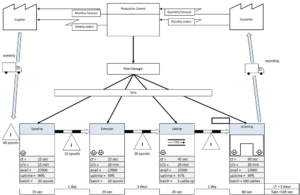What is a Kaizen Value Stream Mapping (VSM) Event?
One of the core skills in Lean Six Sigma practice is knowing how to identify areas where an organization creates value so that essential processes can be easily streamlined. This holds true whether the process is used to process transactions or to manufacture products. Value Stream Mapping(VSM) helps an organization to view value flowing from one area to another, instead of as a series of independent processes and isolated departments. This visualization is essential for Lean Six Sigma deployment.
Reserve a facilitator for an upcoming Kaizen event
Kaizen Value Stream Mapping is a multi-day event that lasts two to five days, depending on size and scope. The event is focused on showing how the process can be mapped from when a customer makes their order or request until delivery of the goods or services. The time from request to fulfillment is considered the customer lead time. It is often shocking to the team how long the lead time process takes. The event’s goal is to build the current state, ideal state, and future state maps of the value stream. After capturing wastes in the process, the team identifies what is preventing the company’s processes from achieving the future state.
Preparing for A Value Stream Mapping Event
This event requires a considerable amount of preparatory work to be accomplished in the form of data gathering and employee input. To find out what information needs to be collected prior to the event, it is vital for the project team to hold discussions with management about problems, products, and processes to establish management’s objectives. It is also necessary to select a preliminary process to act as a lead-in to the other processes that make up the value stream. The process that is selected should be one that is fairly representative–neither the simplest nor the most complex.
Source http://www.breezetree.com/images/vsm-present-state.png
Although value stream mapping has its use in individual thinking, it proves most effective when carried out in a group setting. Within a group, it is key that a facilitator is chosen. Facilitators are important to Kaizen events because they guide sessions, keep discussions on track, and question the conventional wisdom of the group. Teams can concentrate on offering detailed process knowledge and leave the mapping and charting to an experienced facilitator.
Charting The Current State Value Stream Map
A preliminary step in value stream mapping events is the Gemba (go and see) walk through the work area, to give the team a physical feel for the processes and an actual look at any problems that may exist. For office processes, the process can be observed virtually. The facilitator does not necessarily need to know any details of the processes at this point; they only require a cursory overview of the different kinds of processes and their physical layout.
Reserve a facilitator for an upcoming Kaizen event
After the current state map build is complete, the facilitator leads the group in identifying opportunities and wastes within the various processes and goes through the following steps to chart an ideal state map:
- The session starts with standard introductions and the stating of objectives.
- The team then discusses the products or services and agree to focus on a specific one.
- Team members provide a very general description of the process and build an overview.
- Documentation and investigation of various events and steps that fall in-between processes within the value stream.
- Charting of an ideal state map which only outlines processes that add value. It allows the entire team to see the potential of the process and helps them to arrive at a practical compromise.
The “Columbo approach” and brainstorming sessions are the two main ways used to streamline processes within the value stream. The “Columbo approach.” from the old TV series detective, involves asking a set of questions which stimulates thinking, while brainstorming enhances creativity. Generally, the facilitator will combine the two informally, directing the attention of the group to the areas of most opportunity for improvement. Sharp instincts and considerable experience are required to identify these opportunities.
Finally, a future state map is developed looking forward 6-12 months on the basis of the gaps that the team identifies between the ideal state and current state. The resulting Future State Value Stream Map, complete with opportunities, assignees, and improvement milestones which should move the process toward its future state. Many of the improvements lead to detailed Kaizen events to be completed in the next few months.
Once the different potential improvements have been identified, the team may then seek consensus on any additional information required for improvements to commence, what steps can be started right away and what could be delayed to a later date. This is the Action Plan, and it may be drawn up during additional meetings or by a different implementation team.
Conclusion
In summary, the Value Stream Mapping Kaizen event is held over multiple days. A team of cross-functional representatives of the product or service selected is brought together to accomplish the following activities:
- Gemba Walk (go and see)
- Current State Map (with a timeline from a customer perspective)
- Wastes and Opportunities
- Ideal State Map
- Future State Map
- Action Plan to Future State (Gap from Current to Ideal)
Contact us at 6Sigma.us and find out how we can positively help you plan and change the culture and operations of your organization. We offer Six Sigma Green Belt and Six Sigma Black Belt training programs.
SixSigma.us offers both Live Virtual classes as well as Online Self-Paced training. Most option includes access to the same great Master Black Belt instructors that teach our World Class in-person sessions. Sign-up today!
Virtual Classroom Training Programs Self-Paced Online Training Programs







